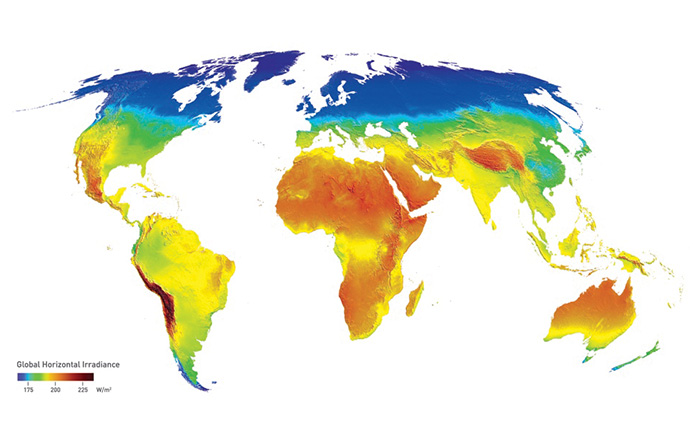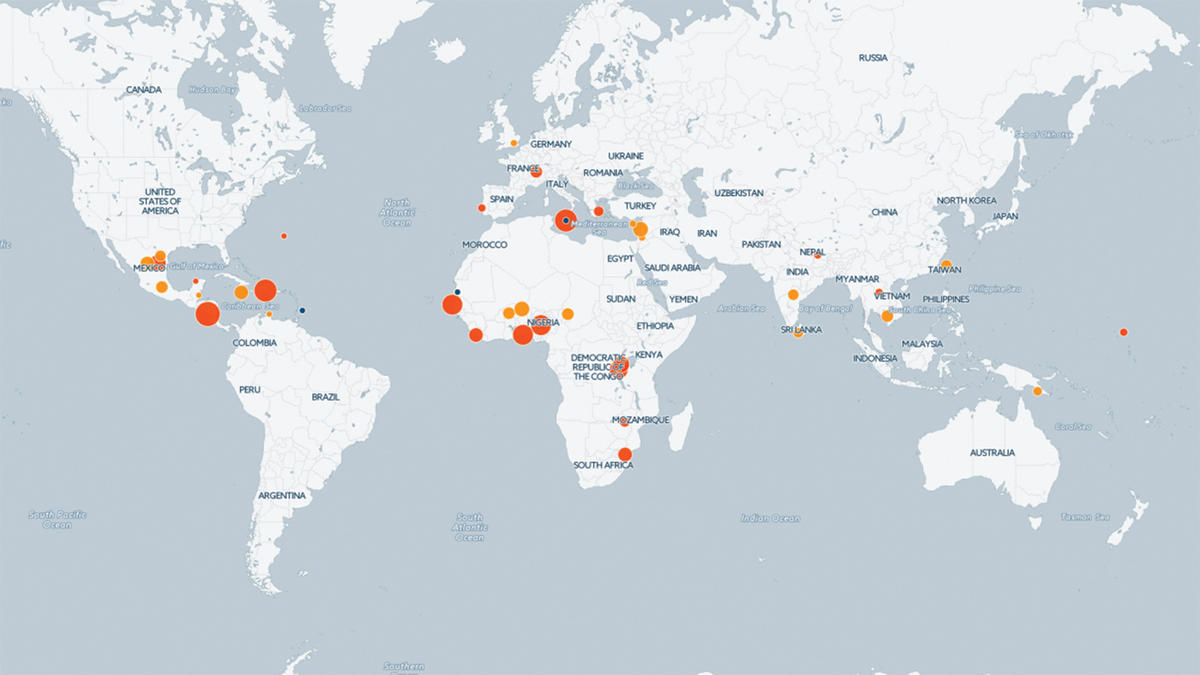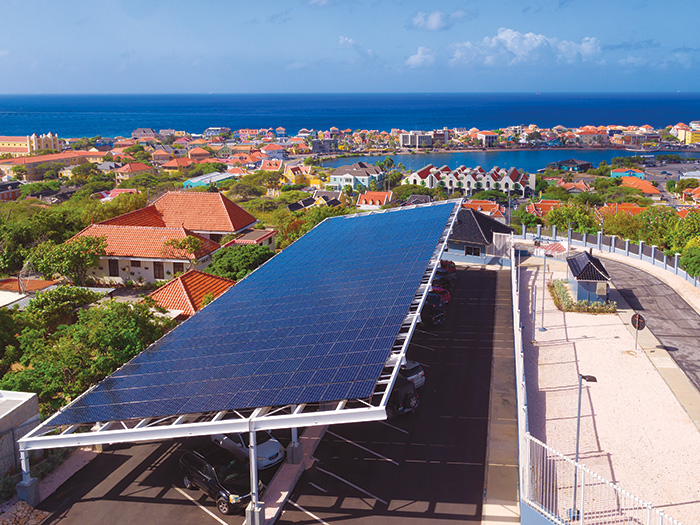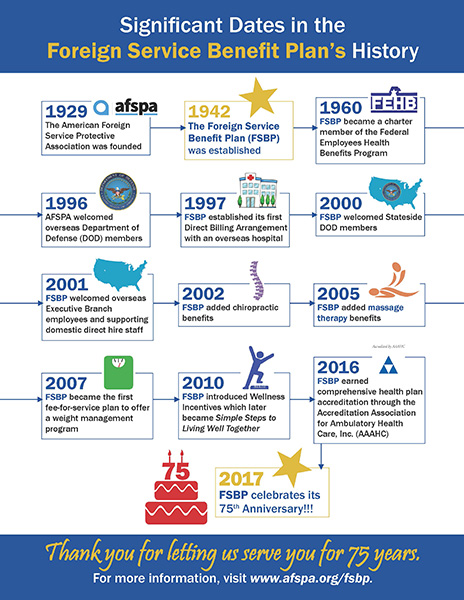Solar Overseas: Harnessing the Sun to Power U.S. Embassies
With the significant, steady drop in the cost of solar energy systems, the State Department has moved to take advantage of this environment-friendly investment.
BY TODD EVANS

Figure 1. Global horizontal irradiance, or how much sunlight reaches the earth.
3tier, Inc.
Solar power systems, once a rarity at diplomatic facilities overseas, have become more commonplace in the past decade. Once in use at only a handful of posts, solar power systems are now installed at 20 posts worldwide, with another 26 systems on the way.
Construction is nearing completion on systems in Nouakchott, Valletta, London, Port-au-Prince and Belmopan. Additional systems are funded, under design or have started construction in Curaçao, Harare, N’Djamena, Bridgetown, Nuevo Laredo, Phnom Penh, Mexico City, Colombo, Beirut, Matamoros, Niamey and Hyderabad.
The increase has much to do with the long-term savings we achieve through these investments. Over the years, we have identified four important components to achieving success.
To ensure a global return on investment in this technology, the first key is to install the equipment in areas known for their irradiance—essentially, sun and clear skies (see Figure 1). The second consideration is the local cost for municipally supplied electricity coupled with the reliability of the local grid. The third key is having the physical space available on the ground, over parking areas or on a roof that is not shaded by surrounding vegetation or structures.
The final and most important factor in the equation for success is the interest and commitment of the local community, along with the ability to perform maintenance on the installation locally. While these arrays are not complicated by moving parts, they do require regular monitoring, cleaning and, sometimes, part replacement.
Sunny Skies
The first key is dictated by geography. Figure 1 shows how much sun energy reaches the earth. If your post is in a bright and clear location, then let’s go ahead and talk about keys two, three and four. If you’re also paying a lot for electricity and you have a staff parking lot that could use a cover or an empty lot that isn’t planned for, then your post is probably a good candidate for a solar power system. But if you live in a dark location, your power is cheap and reliable, and you don’t have a square meter that isn’t covered or planned for, then you’re probably better off continuing to get your juice from the grid. (Sorry, Reykjavík.)
Some posts have areas where nothing can be built—here the array can be mounted on the ground, which is the least expensive option.
Cost of Power
The second key requires a careful look at your utility bill. Installation and system costs have come down steadily and considerably, making the payback on investment much more likely even in locations with lower electricity rates. At the start of the program in 2005, it was common to pay $10 to $12 per installed watt of solar power—including panels, inverters, wiring, installation and computer systems. At that price—two to three times higher than average U.S. electricity costs—systems were only financially profitable in locations where the host government provided a subsidy, where reliance on expensive diesel generation was high—about $0.60 per kilowatt hour per year (kWh)—or where local utility-provided electricity costs were more than approximately $0.30/kWh.
Our most recent systems are being designed and built closer to $3 to $5 per installed watt, thanks to advances in technology and falling component prices, such as the silicon used to fabricate the crystalline panels. Current department-owned systems are estimated to generate electricity for as low as $0.10 to $0.15/kWh, making the systems cost effective for posts paying higher than $0.15/kWh for power. The lower cost allows for broader worldwide deployment and greater energy independence and security for our missions.
Location
The third key is locating a place on government-owned property to install the array: size matters as much as unobstructed sunshine. Canopies over staff parking lots are prime candidates for solar arrays. Staff parking lots are typically not candidates for future building projects, and even with the added cost of building a structure to support the array, the extra benefits of shading vehicles, ease of accessible maintenance and possible rainwater capture make them preferred sites. Some posts have areas where nothing can be built—here the array can be mounted on the ground, which is the least expensive option. Arrays can be mounted on building roofs, but this complicates long-term maintenance of both the system and the roof.

Figure 2. The State Department’s Bureau of Overseas Buildings Operations is installing solar and wind power technologies around the world. The three dark blue dots shown on this map represent installed wind turbines. The orange dots represent installed solar systems, and the gold dots are solar systems under construction or being planned. The size of the dot indicates the relative size of the system—larger dots, larger systems; smaller dots, smaller systems.
U.S. State Department / OBO
Local Support and Regular Checkups
For the most part, these systems need little care or feeding as they passively lower the cost of your electricity bill. Dust will build up, but is often washed away naturally by rain. If not, then cleaning can improve productivity; but the cleaning may cost more than the increased productivity. Calculate the benefit before you bring out the hose.
A general weekly observation tour is recommended to make sure all the wiring is neat and tidy, and none of the solar panels themselves are damaged. In West Africa, for example, panels have to be checked frequently because birds often pick up rocks or crustaceans and drop them on the panels. A few posts, such as Geneva and Managua, have contracts in place to have a specialist keep an eye on the equipment and perform preventive maintenance.
Visual inspections aren’t always enough—the best way to tell if something’s up is by looking at the system output. All of OBO’s systems are equipped with a computer that tracks and shows their production. Every system gets weaker with age, but if you’re seeing a dramatic drop in production, it may be a sign that something like an individual solar panel or piece of electrical equipment has failed.
Critical Components

Solar panels cover a parking area at the U.S. consulate general in Curaçao.
Courtesy of Con Gen Curaçao
When people look at a solar power system, they generally look at the solar panels themselves and assume there’s some wiring voodoo that converts all of that sweet sunshine into electricity for our use. The biggest part of that “voodoo” is the inverter. These boxes turn the direct current electricity the solar panels generate into alternating current electricity. After the panels themselves, these boxes are the second place maintenance staff should look when they suspect a failure.
Solar panels generally carry a 25-year power production warranty. Productivity varies, but even at the end of their life, you can expect them to generate 85 percent of the electricity that they did when they were new. Inverters, on the other hand, have a much shorter life. Inverters on systems built in the mid- to late-2000s have warranties of about 10 years. As the technology has improved in recent years, though, it is becoming more common to see inverters with 15- to 20-year warranties.
Mid-Life and End-of-Life
As these systems age, facilities staff should regularly check that everything continues to operate effectively. When the system reaches 25 years of use, there are a few choices to consider. Do we leave the panels in place and continue to harvest what power is possible? Or should we invest in a new system that is more efficient and potentially less expensive than the one it is replacing? We’ll find out together as these systems start to reach the end of their useful and productive lives.
Bring on the Solar: A How-To
If you’re interested in bringing solar to your post, where do you start? Is there training available for local maintenance staff who might be put in charge of such a system?
If you’re in a sunny location and paying more than $0.15 per kilowatt-hour for electricity, or rely on diesel generators for your electricity, reach out to OBO and we can see if solar power makes sense for you.
The National Renewable Energy Laboratory, a laboratory of the U.S. Department of Energy, has some public guidance on best practices for solar power system operations and maintenance. Go to www.bit.ly/SolarBestPractices.
What about solar for housing? Is the State Department considering adding solar to overseas housing?
OBO makes renewable energy investments with the expectation of a positive return on that investment. In fact, the law (10 CFR 436) requires our return-on-investment (ROI) to be greater than 3 percent. Even in the best of cases, it takes a solar power project seven to 10 years to meet that ROI requirement.
Given those financial constraints, two things complicate our ability to invest in renewable energy at our overseas housing. First, although there are exceptions to this, our residences often pay a lower unit cost for electricity than our office buildings. So the value of a renewable energy system at a residence is often lower than it would be just down the street at our embassy or consulate.
Second, our housing supply is largely leased. We can’t justify the cost of installing a solar power system that will take 12 years to meet our financial requirements at a location that is only leased for five or 10 years.
That being said, we are beginning to see cases where it does make financial sense to install renewable energy systems at housing that we own overseas. Chief-of-mission residences, deputy chief-of-mission residences and staff diplomatic residences are all starting to be evaluated for renewable energy deployment. The housing complex in Port-au-Prince, which is nearing completion, will include solar power.
—Todd Evans










